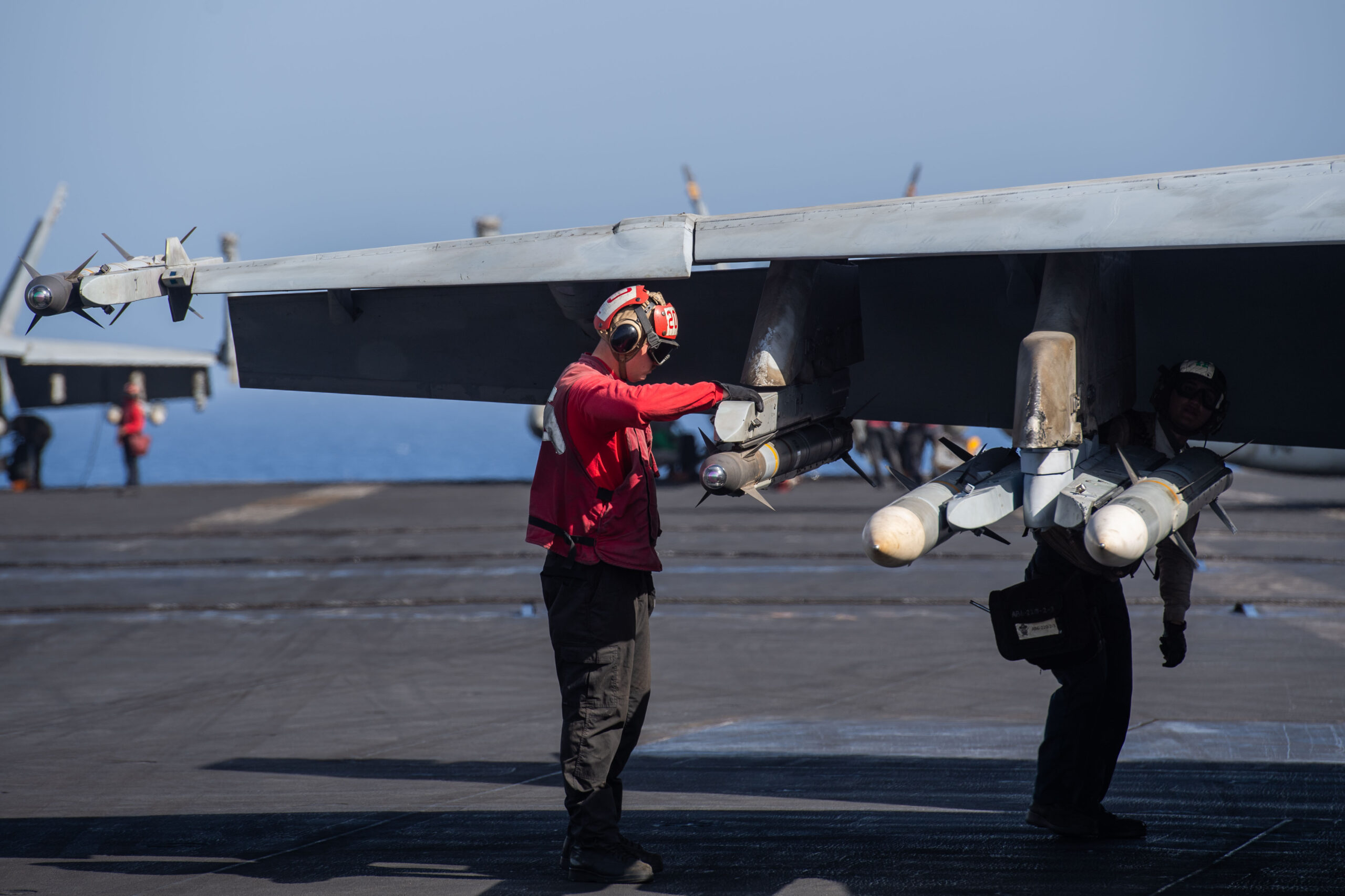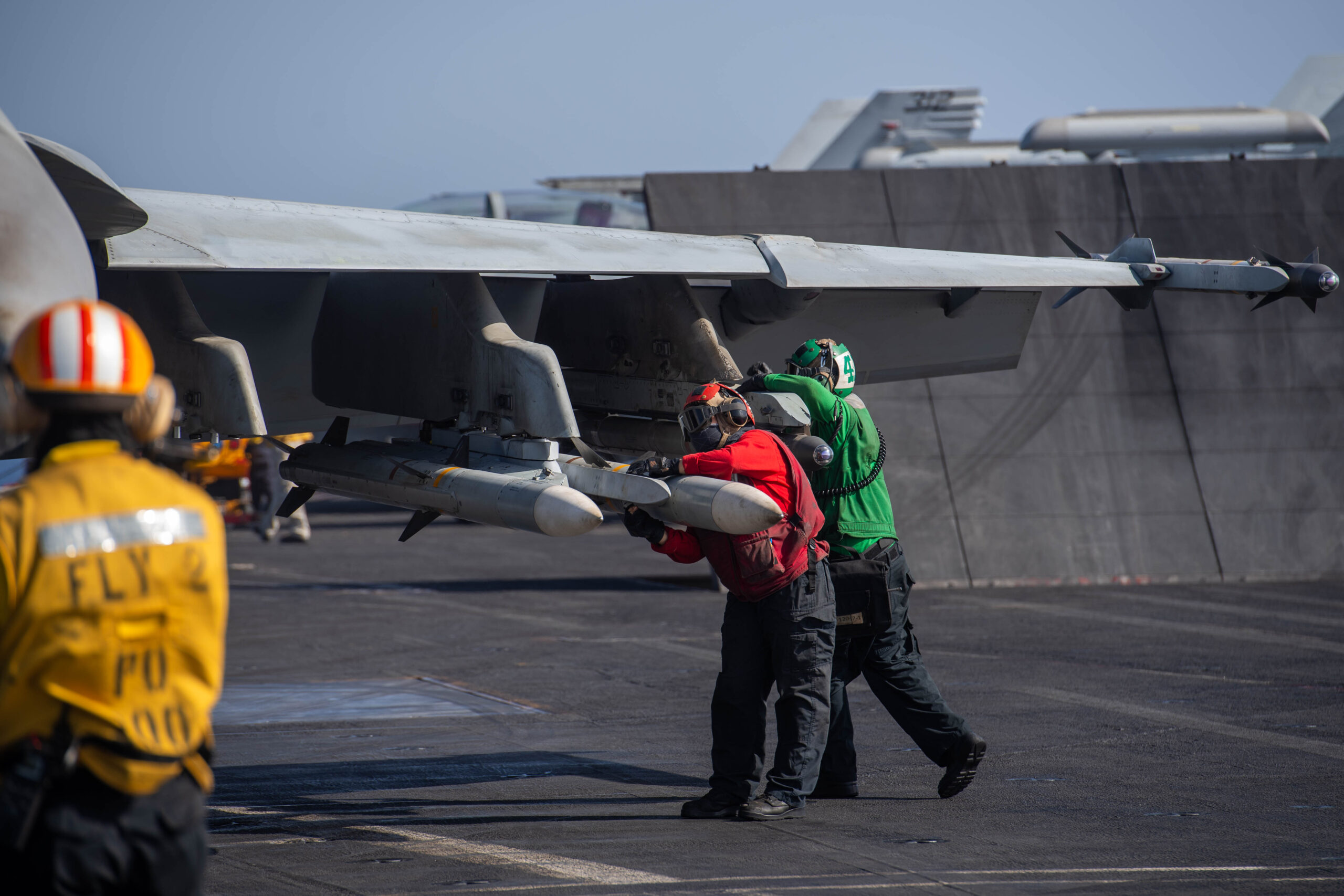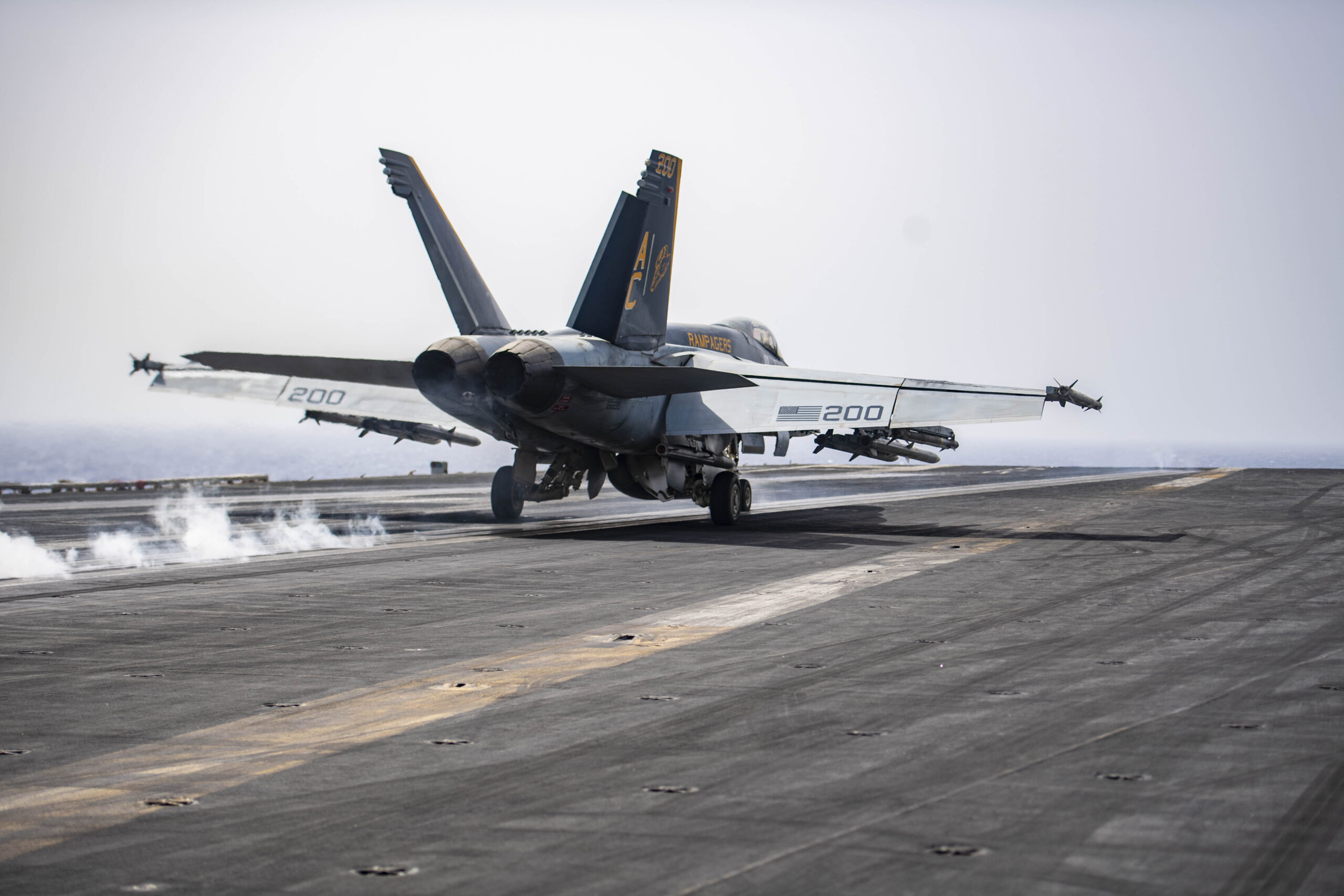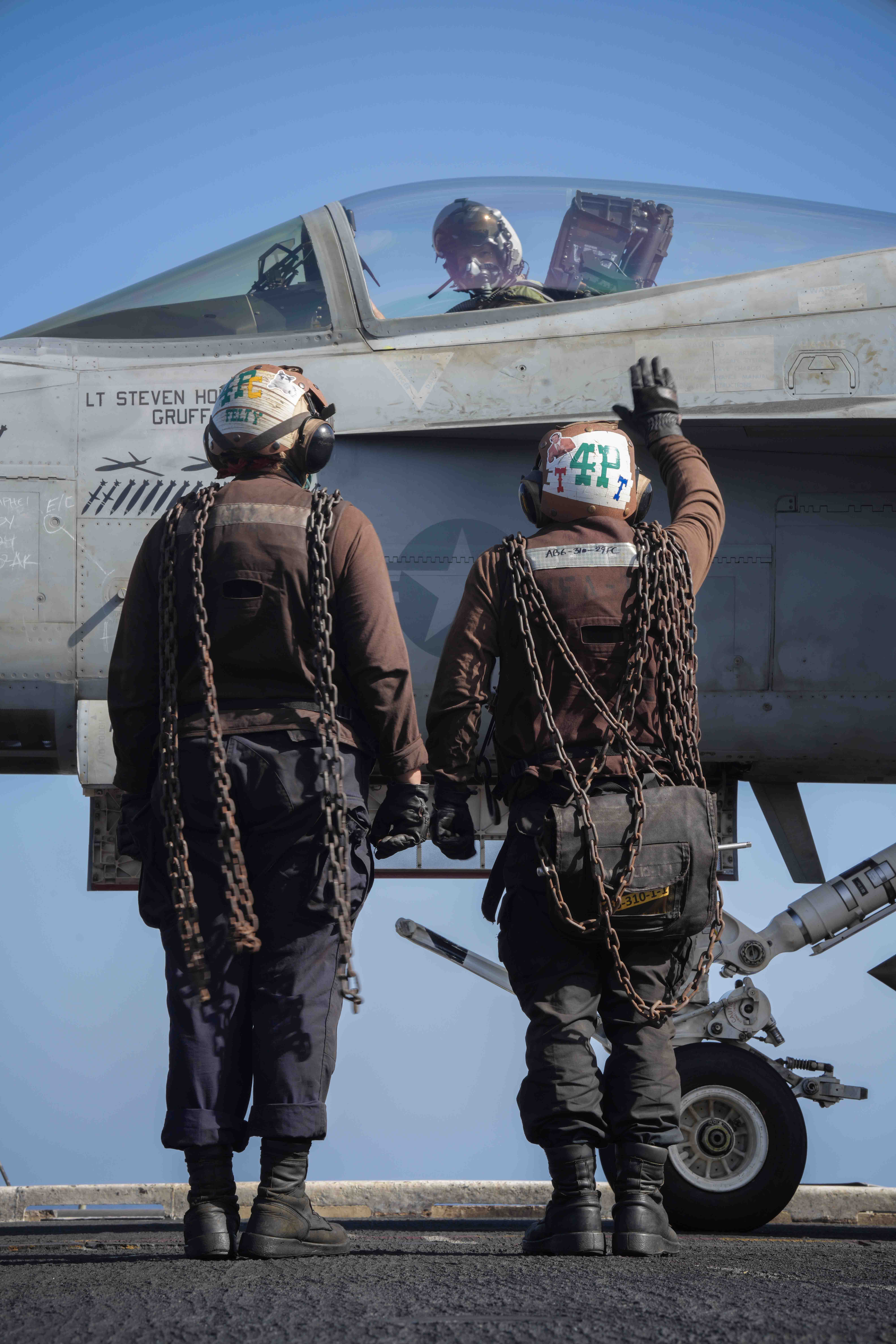After a crash program to outfit them with additional missile capacity to shoot down Houthi drones, U.S. Navy F/A-18E/F Super Hornets are now flying patrols armed with a load-out of nine air-to-air missiles, which includes four AIM-9X Sidewinders.
TWZ was first to break the news that the Navy had certified its F/A-18E/F Super Hornets, as well as EA-18G Growlers, to carry AIM-9X Sidewinder short-range air-to-air missiles on their outer underwing stations and we saw the first evidence of them doing so not long after.
Now, new photos published by the Navy showing F/A-18E Super Hornets from Strike Fighter Squadron (VFA) 83, the “Rampagers,” and from VFA-105, the “Gunslingers,” launching from the flight deck of the Nimitz class aircraft carrier USS Dwight D. Eisenhower (aka IKE). The jets in question carry a live armament of five AIM-120 AMRAAMs and four AIM-9X Sidewinders air-to-air missiles, as well as an AN/ASQ-228 Advanced Targeting Forward-Looking Infrared (ATFLIR) targeting pod and a centerline 480-gallon fuel tank. They were photographed during flight operations in the Red Sea on April 19-20.


IKE steamed through the Red Sea, into the Suez Canal, and arrived in the Mediterranean recently after being on station in the Gulf of Aden for months. After a port visit in Greece, it seemed the supercarrier could be headed home some six months after it set off on its cruise, but that is not the case. It is now back on station near the Yemeni coastline.
In the newly released images of flight operations on IKE, the two ‘new’ Sidewinders are seen on the outboard underwing pylons (stations 2 and 10) of the Super Hornets, complementing the two on the wingtip rails, where they have long been routinely fitted since the jet’s inception.

Potentially, another AMRAAM could be carried on the left intake station, for a total of 10 air-to-air missiles, although in this instance the station is loaded with the aforementioned ATFLIR pod. Advanced targeting pods are critical components of a modern tactical fighter’s air defense arsenal as they allow for beyond-visual-range positive identification of targets. This is especially important in densely populated and complex airspace, and can lead to quicker identification friend or foe and the ability to fire on a target with confidence long before it would be within the rules of engagement otherwise. ATFLIR’s infrared and TV sensors can be slaved to the Super Hornet’s radar and vice-versa, adding an extra layer of integrated targeting.
The pods can also collect important intelligence on aerial targets, whether they are engaged or not. A secondary quasi-infrared search and track mode is also available on some pods that can provide detection of stealthy targets, although this is not nearly as capable as a dedicated advanced IRST sensor system.
So, while the ATFLIR pod may take up a streamlined station where another AMRAAM could go, it’s well worth the trade.

The extra Sidewinder capacity was added to the Super Hornet and Growler to provide more ‘magazine depth’ to shoot down Houthi drones. For the Navy’s EA-18Gs, the AIM-9X was an entirely new option added to their armory.
The need for this expanded air-to-air capacity became clear during IKE’s months on station in the Gulf of Aden, where it’s part of a task force that is defending shipping in the region while degrading the ability of the Iranian-backed Houthi rebels in Yemen to continue to threaten that shipping.
The effort to boost the number of Sidewinders carried by F/A-18E/Fs and introducing the same weapon to the Navy’s EA-18Gs represented “a critical need … in support of [operations in and around the] Red Sea,” Rear Admiral Tedford, head of Naval Air Systems Command’s Program Executive Office for Unmanned Aviation and Strike Weapons, said last month. Doing this “gave us a lot more firepower and capability immediately in support of Red Sea operations and counter-UAS [uncrewed aerial systems].”
You can read our initial report about the expanded weapons carriage plans here.
Even before the up-armed Super Hornets began to appear on the carrier, these jets were rapidly responding to pop-up drone and cruise missile threats heading toward commercial shipping and allied warships.
In the process, these aircraft have shot down multiple Houthi drones in recent months, following a first known kill that occurred in late December.
The growing tally of downed Houthi drones has become manifest in kill markings that are popping up on the noses of various Super Hornets in IKE’s air wing. Some of the latest such ‘scoreboards’ have also appeared in recent U.S. Navy photos, as seen below.

Once again, the drone symbol on the Navy jets appears to represent one of the Sammad family of one-way attack drones widely used by the Houthis, but it is most likely a generic symbol. Bomb and AGM-88 High-speed Anti-Radiation Missile (HARM) markings have also been stenciled onto the jets, representing successful air-to-ground strike and suppression of enemy air defense missions.
With no sign of the crisis in the region being resolved anytime soon, we are likely to continue to see such heavily armed air-defense-optimized Super Hornets — as well as Growlers — operating here for the foreseeable future. With the option to potentially carry as many as 14 air-to-air missiles, there’s a possibility we could see even heavier air defense load-outs, too.

At the same time, the boosted Sidewinder loadout for the Super Hornet (and the introduction of the AIM-9X on the Navy’s Growler) has obvious applications for other scenarios, too.
Combined with the option of making shots cued by the helmet-mounted display, the AIM-9X offers robust close-range capabilities, including against drones that are a growing concern in various other theaters and operational contexts. Some targets that may be a challenge for radar-guided weapons could be better suited for infrared ones, as well, especially depending on environmental factors. With all this in mind, the additional defensive flexibility provided by the up-armed Super Hornets and Growlers will almost certainly be of considerable utility in scenarios beyond the Gulf of Aden.
Contact the author: thomas@thewarzone.com
